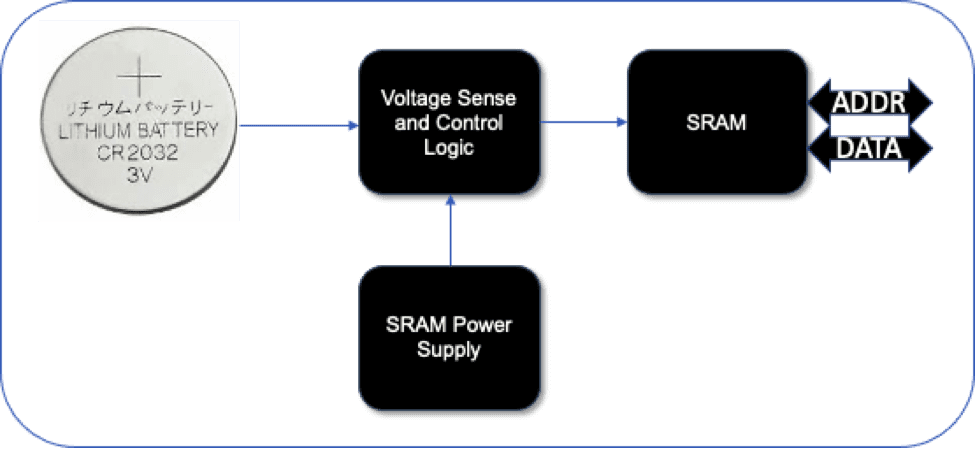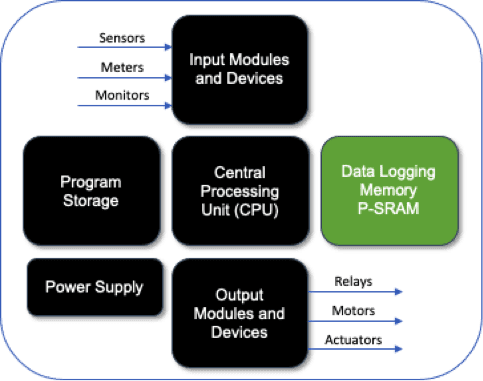Industrial automation systems like PLCs scan the states of inputs such as proximity sensors, pressure sensors, temperature sensors, humidity sensors, switches, push buttons etc. and control outputs such as relays, valves, solenoids, actuators, motors, fans, alarms etc. These systems are usually real-time systems since the output states must be generated in response to the input states within a finite time. Failure to do so might result in injuries, loss of human life, or negatively impact productivity, efficiency and other metrics that indicate how well an industrial plant is managed. Figure 1 shows the block diagram of an industrial automation system.

These real-time industrial automation systems require external non-volatile expansion RAM memory to log messages, and data related to alarms and contents of internal registers, state of environment variables etc. This functionality is generically called Data Logging and requires the RAM to have high endurance to survive many repeated read-write operations. This RAM also needs to be capable of fast and reliable writes in order to protect data in the event of unexpected power loss.
Long before most of us started our careers, in the EEPROM and Flash eras, engineers used Battery-Backed SRAM (BB-SRAM) as a non-volatile memory for data logging. In such an implementation a battery powers the SRAM during unexpected power loss events. Figure 2 shows a block diagram of a BB-SRAM implementation. Figure 3 shows actual industrial automation boards and modules with BB-SRAM.


Born out of necessity, since EEPROM and Flash did not have the required endurance and reliability, BB-SRAM suffers from several drawbacks arising from its dependence on batteries. The biggest drawback is that these systems require regular maintenance to monitor and replace batteries. Additional drawbacks include higher cost, bulky size, disposal of spent batteries, complicated RoHS compliance, higher access time and unpredictable data retention. In some cases, batteries and/or modules are soldered on the printed circuit boards which makes battery replacement all the more expensive. In spite of these drawbacks BB-SRAM is still used in industrial automation systems, although usage is declining slowly as alternative memory technologies have become commercially viable. Spin Transfer Torque MRAM (STT-MRAM) is one such alternative – a modern, random access, high reliability, maintenance free, ecologically friendly, truly non-volatile memory.
| BB-SRAM | P-SRAM |
| Requires a battery | Battery free |
| Imposes ecological hazard, battery disposal problem, RoHS issues | RoHS compliant, environment friendly |
| Requires ongoing monitoring and periodic maintenance to ensure battery is healthy and data can be retained | No maintenance requirements |
| Battery vulnerable to moisture, shock and vibration | No vulnerability to moisture, shock and vibration |
| Requires additional board space | Standard expansion RAM board space requirements |
| Increases design complexity – must design additional supply voltage monitoring and switching circuitry, battery charge level monitoring circuitry | Standard expansion RAM design complexity |
| Increases software driver development – must develop driver to monitor battery charge levels and alert operator when charge level drops below a preset threshold to replace the battery | Standard expansion RAM driver development |
| Data retention depends on remaining battery charge at the time of power loss | Data retention is greater than 20 years |
| Typically uses ultra-low power SRAMs which have high access times (55ns or more) | Access time as low as 35ns with standard parallel async SRAM interface, as low as 10ns access time with Q-SPI interface |

Avalanche’s Persistent SRAM (P-SRAM) products are based on proprietary highly reliable STT-MRAM technology. These products offer truly non-volatile, random access memories that are ideal for applications that must store and retrieve data without incurring large latency penalties. They offer low power, and virtually infinite endurance and retention, and are ideal for non-volatile memory applications such as program storage and data logging in Factory Automation, Motor Control, Human Machine Interfaces, Smart Meters, and Multifunction Printers. P-SRAM products are available in a standard 35 nanosecond asynchronous SRAM interface as well as standard SPI and high-performance Q-SPI interfaces. While the parallel interface products enable easy migration from BB-SRAM implementations, the serial interface products simplify board design and are available in small footprint packages that are ideal for form-factor-constrained Industrial Internet of Things and Industry 4.0 applications.
Learn more about Avalanche Technology P-SRAM products HERE.
